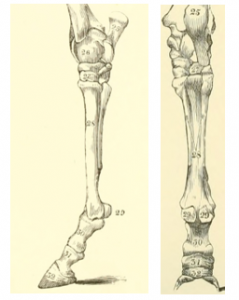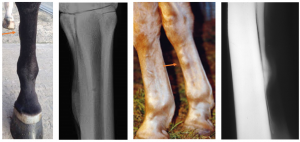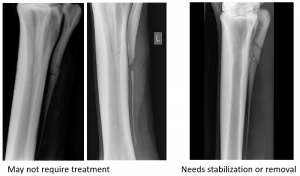Equine bone disorders
Splint bone disorders
Splint bones bear at least partial weight from the upper body and are easily traumatized due to their location.

Lateral splint bones are at risk from other horses and firm objects. Medial splint bones can be hit by the opposite limb. Medial splint bones articulate fully with the medial cuboidal bones (C2, T2) while the lateral splint bones have much less weight imposed on them. Medial splints can be affected by arthritis at the carpometacarpal joint due to the extra weight bearing.
Splint bone exostoses
The most common abnormality is a lumpy splint bone due to periosteal damage. These are called “splints” in lay terminology. Owners may not have observed the trauma or even detected these at the stage of inflammation. Many are identified as incidental findings after the inflammation has resolved.

If detected early, the area will be warm and painful on palpation. The horse may be lame. The lameness and inflammation respond well to stall rest and NSAIDs for 3-5 days.
If detected later, the area will be cool, nonpainful and firm. No treatment is advised at this stage.
Occasionally the exostoses will form more deeply and axially, and will rub on the suspensory ligament, creating lameness from suspensory desmitis. These exostoses need surgical removal.
Splint bone fractures
Splint bone fractures will usually heal if there is no associated wound. Many are comminuted and the blunt trauma or contamination associated can lead to avascularity and sequestration.
If the fracture is in the proximal 1/3 of the bone, the head of the splint may pop outward due to pull of proximal ligaments. These will usually require bone plate repair; however, MTIV (lateral hindlimb splint) has minimal function and can be removed.

Key Takeaways
“Splints” are periosteal reaction secondary to trauma. These rarely need much treatment.
Splint bone fractures may or may not need surgery; proximal fractures need attention.
inflammation of a ligament

